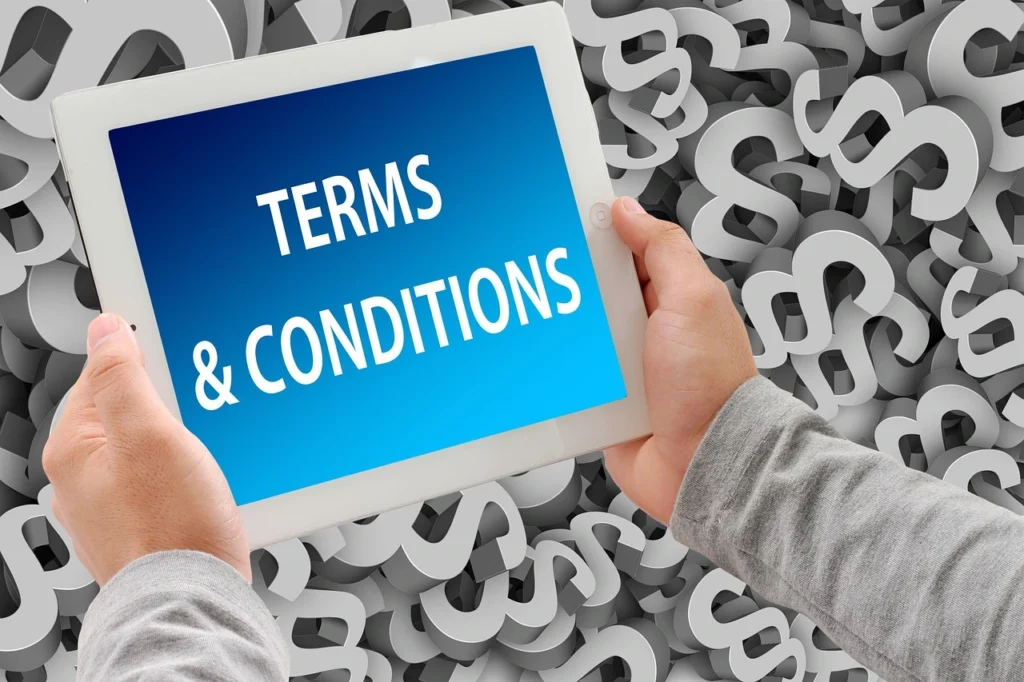
В эпоху цифровых технологий, когда транзакции и взаимодействия все чаще происходят в Интернете, важность хорошо разработанных Условий и положений (Условий и положений) невозможно переоценить. Для бизнеса понимание роли Условий и положений имеет решающее значение для защиты интересов компании, обеспечения соблюдения нормативных требований и укрепления доверия среди пользователей. В этой статье мы расскажем, почему условия и положения жизненно важны для вашего бизнеса, и посоветуем, как разработать эффективные из них. После прочтения статьи, пожалуйста, вернитесь к нам, если вы хотели бы получить консультацию.
Правовая защита и снижение рисков
Одной из основных функций Правил и условий является обеспечение правовой защиты Вашего бизнеса. Они служат юридически обязывающим договором между вашей компанией и ее пользователями, в котором излагаются правила и рекомендации по использованию ваших услуг или продуктов. Четко определяя, что разрешено, а что нет, Условия и положения могут помочь снизить риски и снизить вероятность споров.
Ключевые правовые меры защиты включают:
-Ограничение ответственности: Четкое указание степени ответственности вашей компании в случае ошибок, ущерба или убытков может защитить вас от потенциальных судебных исков[2].
— Права на интеллектуальную собственность: Условия и положения могут помочь защитить интеллектуальную собственность вашей компании, подробно описывая, как может быть использован ваш контент, товарные знаки и патенты[2].
— Применимое право: Указание юрисдикции, в соответствии с которой будут разрешаться любые споры, может обеспечить юридическое преимущество и предсказуемость[5].
Обеспечение соответствия нормативным требованиям и нормативным требованиям
Для компаний, работающих в нескольких юрисдикциях, Условия и положения имеют важное значение для обеспечения соблюдения местных законов и нормативных актов. Они могут помочь вашей компании соблюдать законы о защите прав потребителей, правила конфиденциальности данных (например, GDPR или FADP) и отраслевые стандарты.
Преимущества для соблюдения нормативных требований:
-Прозрачность: Четко сформулированные условия могут повысить прозрачность, информируя пользователей об их правах и обязанностях[2].
-Защита данных: Включение положений о сборе, использовании и хранении данных может помочь обеспечить соблюдение законов о защите данных[2].
— Права потребителей: В Условиях и положениях могут быть изложены политики возврата, гарантии и механизмы разрешения споров в соответствии с законами о защите прав потребителей[1].
Укрепление доверия и авторитета с помощью Правил и Условий
В эпоху, когда потребители все больше беспокоятся о конфиденциальности и безопасности, прозрачные и всеобъемлющие условия могут помочь укрепить доверие и доверие. Пользователи с большей вероятностью будут взаимодействовать с компанией, которая четко сообщает о своих политиках и практиках.
Элементы укрепления доверия:
-Ясность: Простой язык с понятными терминами может сделать ваши Правила и условия более доступными и понятными для пользователей[3].
-Справедливость: Справедливые и разумные условия могут улучшить репутацию вашей компании и способствовать долгосрочным отношениям с клиентами[2].
-Последовательность: Регулярное обновление Условий и положений с учетом изменений в законодательстве или деловой практике демонстрирует приверженность прозрачности и подотчетности[3].
Создание эффективных условий и положений
Создание эффективных Условий и положений требует тщательного баланса между юридической тщательностью и удобством для пользователя. Вот несколько рекомендаций, которые следует рассмотреть:
Рекомендации:
— Проконсультируйтесь с экспертами по правовым вопросам: Работайте с профессионалами в области права, чтобы убедиться, что ваши Условия и положения являются всеобъемлющими и соответствуют действующему законодательству[2]. Пожалуйста, свяжитесь с нами для получения более подробной информации.
— Будьте конкретны: четко определите ключевые условия и положения, чтобы избежать двусмысленности[4].
— Будьте проще: Используйте простой язык, чтобы сделать ваши Условия и положения доступными для более широкой аудитории[3].
— Регулярные обновления: Периодически пересматривайте и обновляйте свои Условия и положения, чтобы отражать изменения в законах, деловых операциях или отраслевых стандартах[2].
— Выделите ключевые моменты: Используйте заголовки, маркированные списки и резюме, чтобы выделить важные разделы и сделать документ более удобным для навигации[3].
Ключевые элементы, которые следует включить в документ с условиями и положениями
Хорошо составленный документ Правил и условий имеет важное значение для определения правовых отношений между бизнесом и его пользователями. Он обеспечивает основу для использования услуг или продуктов, защищает интеллектуальную собственность и ограничивает ответственность. Вот ключевые элементы, которые должны быть включены в документ Правил и условий:
1. Введение
-Согласие с Условиями: Четко указать, что, используя сервис, пользователи соглашаются с Условиями и положениями.
-Определения: Определите ключевые термины, используемые во всем документе, чтобы избежать двусмысленности.
2. Обязанности и ответственность Пользователя
-Допустимое использование: Опишите приемлемое и запрещенное поведение на платформе.
-Пользовательский контент: Укажите правила, касающиеся отправки и использования пользовательского контента, включая условия владения и лицензирования.
3. Права на интеллектуальную собственность
— Право собственности на контент: Уточните, кому принадлежит контент, представленный на сайте, включая текст, изображения и программное обеспечение.
— Права на использование: Подробно опишите, как пользователи могут использовать контент и любые ограничения на его использование.
4. Ограничение ответственности и отказ от ответственности
-Ограничения ответственности: Ограничьте ответственность компании в случае ошибок, ущерба или убытков, понесенных пользователями.
-Отказ от ответственности: Включите отказ от ответственности в отношении гарантий, таких как точность и надежность предоставленной информации.
5. Регулирующее законодательство и разрешение споров
-Регулирующее законодательство: Укажите юрисдикцию и законы, которые регулируют Правила и условия.
-Разрешение споров: Опишите процесс разрешения споров, включая арбитражные или посреднические оговорки, если применимо.
6. Условия оплаты (если применимо)
-Ценообразование и оплата: Подробно опишите цены, способы оплаты и любые применимые налоги.
-Политика возврата и отмены: Объясните условия, при которых возможен возврат или отмена.
7. Политика конфиденциальности
— Сбор и использование данных: Информируйте пользователей о типах собираемых данных и о том, как они будут использоваться.
— Права пользователя: Опишите права пользователей в отношении их данных, такие как доступ, исправление и удаление.
8. Изменение Условий
— Изменения в Условиях и положениях: Укажите, что компания оставляет за собой право изменять Условия и способы уведомления пользователей об изменениях.
— Согласие пользователя с изменениями: Поясните, что продолжение использования сервиса означает принятие новых условий.
9. Прекращение действия
— Приостановка или прекращение действия учетной записи: укажите условия, при которых учетная запись пользователя может быть приостановлена или прекращена.
— Последствия прекращения: опишите, что происходит с пользовательскими данными и контентом после прекращения.
10. Прочие положения
— Автономность положений: Убедитесь, что если одна часть Правил и условий будет признана недействительной, остальная часть останется подлежащей исполнению.
— Полнота соглашения: Укажите, что Условия и положения представляют собой полное соглашение между сторонами и заменяют собой любые предыдущие соглашения.
Элементы дизайна, которые сделают ваши правила и условия более доступными
Создание документа «Условия и положения» в доступных условиях гарантирует, что все пользователи, в том числе с ограниченными возможностями, могут понять и согласиться с вашими условиями. Вот некоторые ключевые элементы дизайна, которые следует учитывать:
1. Четкие и описательные заголовки
— Подзаголовки: Разбейте контент с помощью четких и описательных подзаголовков. Это помогает пользователям, особенно использующим программы чтения с экрана, легче[11] перемещаться по документу.
— Согласованная структура: Используйте последовательную иерархию заголовков для логической[13] организации контента.
3. Text Alternatives for Visual Content
— Замещающий текст для изображений: Предоставьте описательный замещающий текст для любых диаграмм, фотографий или другого визуального содержимого, чтобы пользователи с нарушениями зрения могли получить доступ к информации[12].
— Избегайте чрезмерного стиля: Сохраняйте простой дизайн с минимальным использованием декоративных элементов, которые могут отвлечь или сбить с толку пользователей[11].
4. Высокая контрастность и использование цвета
— Цвета с высокой контрастностью: используйте высокий контраст между текстом и фоном, чтобы обеспечить удобочитаемость для пользователей с нарушениями[12] зрения.
— Избегайте индикаторов, содержащих только цвет: не полагайтесь исключительно на цвет для передачи информации. Используйте дополнительные индикаторы, такие как иконки или жирный текст[12].
5. Интерактивные и навигационные средства
— Оглавление: Включите оглавление в начало документа, чтобы помочь пользователям быстро найти определенные разделы[14].
— Функция поиска: Добавьте строку поиска для длинных документов, чтобы пользователи могли быстро[13] находить конкретные термины или предложения.
— Всплывающие информационные пузыри: Используйте всплывающие информационные пузыри для предоставления дополнительных объяснений сложных терминов, не загромождая основной текст[13].
6. Удобные варианты приема
— Флажок или кнопка: Предоставьте простые методы принятия, такие как флажок или кнопка «Согласен». Не требуйте подписи, так как некоторые пользователи могут не иметь возможности их предоставить[11].
— Четкий призыв к действию: используйте четкие и конкретные призывы к действию, чтобы помочь пользователям пройти через процесс[13] принятия.
7. Читабельный и понятный язык
— Простой язык: Пишите простым языком, избегая юридического жаргона и сложных предложений. Это делает документ более доступным для более широкой аудитории[13].
8. Accessible Formatting
— Маркированные списки и списки: используйте неупорядоченные и упорядоченные списки, чтобы представить информацию в структурированном и удобном для чтения формате[11].
— Достаточное белое пространство: Используйте достаточное белое пространство, чтобы не перегружать пользователей плотными блоками текста[13].
Заключение
Для бизнеса инвестирование в хорошо продуманные Правила и условия является не только юридической необходимостью, но и стратегическим императивом. Они обеспечивают необходимую правовую защиту, обеспечивают соответствие нормативным требованиям и укрепляют доверие пользователей. Отдавая приоритет четким, справедливым и актуальным условиям и положениям, ваш бизнес может уверенно и добросовестно ориентироваться в сложностях цифрового ландшафта.
В мире, где малейшая оплошность может привести к значительным последствиям, пусть ваши условия и положения станут краеугольным камнем вашей бизнес-стратегии, защищая ваши интересы и повышая вашу репутацию. Хорошо составленные условия могут предотвратить недоразумения, снизить риск юридических споров и обеспечить четкую основу как для ваших бизнес-операций, так и для взаимодействия с клиентами.
Кроме того, прозрачные и удобные условия демонстрируют вашу приверженность этическим нормам ведения бизнеса и правам пользователей, способствуя долгосрочной лояльности и доверию. Они также могут служить конкурентным преимуществом, выделяя ваш бизнес на переполненном рынке, показывая, что вы цените ясность и справедливость.
Помните, что Правила и условия не являются статичными документами. Крайне важно регулярно пересматривать и обновлять их, чтобы отражать изменения в законах, деловой практике и отзывах пользователей. Такой проактивный подход гарантирует, что ваши Условия и положения останутся актуальными и эффективными для защиты вашего бизнеса и обслуживания ваших пользователей.
DGVM будет рад сделать ваши бизнес-идеи немного лучше. Наш опыт в разработке всеобъемлющих и доступных условий и положений может помочь вам создать прочную правовую основу, улучшить пользовательский опыт и, в конечном итоге, способствовать успеху вашего бизнеса. Позвольте нам помочь вам в создании Условий и положений, которые не только соответствуют требованиям законодательства, но и согласуются с ценностями и целями вашего бизнеса.
Ссылки:
[2]https://www.iubenda.com/en/help/2859-terms-and-conditions-when-are-they-needed
[3]https://www.termsfeed.com/blog/terms-conditions-individual/
[5]https://emlaw.co.uk/terms-incorporated-by-reference-contract-law/
[7]https://www.iubenda.com/en/help/2859-terms-and-conditions-when-are-they-needed
[8]https://www.iubenda.com/en/help/19482-what-should-basic-terms-and-conditions-include
[9]https://ironcladapp.com/journal/contracts/elements-of-a-contract/
[10]https://termly.io/resources/templates/terms-and-conditions-template/
[11] https://www.boia.org/blog/how-to-make-your-websites-terms-and-conditions-page-accessible
[12] https://accessibility.uncg.edu/make-content-accessible/design-elements/
[13] https://pronovix.com/blog/increase-trust-enhancing-ux-your-devportals-terms-and-conditions
[14] https://www.mindtheproduct.com/improving-ux-terms-conditions-page-6-easy-ways/




